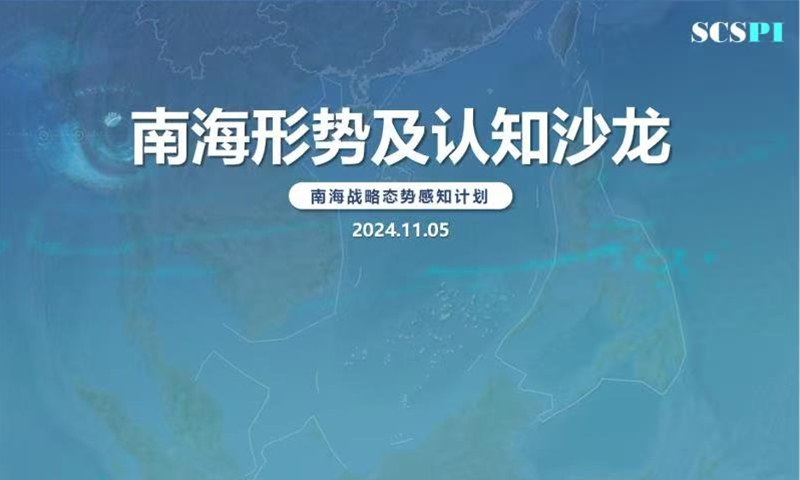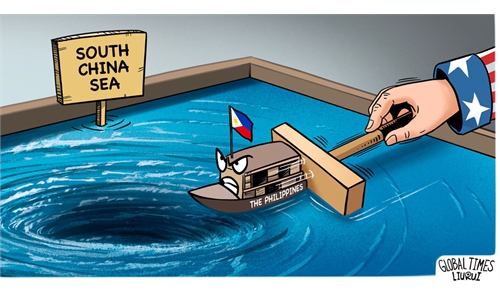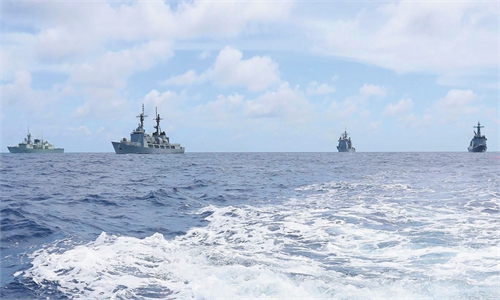Illegal claims, external meddling among factors undermining S.China Sea stability: scholars

The seminar on South China Sea current situation is held online on November 5, 2024. Photo: Courtesy of SCSPI
Amid ongoing tensions in the South China Sea, Chinese experts at a seminar on Tuesday highlighted illegal claims by nations like the Philippines, along with external interventions and provocations against China, as key sources of instability and turbulence in the region. Some noted the risk of a large-scale conflict in the South China Sea remains low, but they predicted that the Philippines may continue low-intensity maritime frictions with China during the US' government's transition period after the presidential election.
What are the root causes of the current instability in the South China Sea? Wu Shicun, founding president of the National Institute for South China Sea Studies, attributed it to three main factors: first, the US has openly picked sides on the issue, standing against China; second, some claimant countries are trying to solidify their interests via illegal ways; and third, the 2016 South China Sea Arbitration ruling has almost completely denied China's reasonable claims of its rights in the South China Sea.
Hu Bo, director of South China Sea Strategic Situation Probing Initiative (SCSPI), said that China's claims to sovereignty and maritime rights in the South China Sea have remained consistent since 1947. Since the late 1990s, China's policy has focused on "shelving differences" and maintaining the status quo. "If there has been any change, it is in China's enhanced capability and resolve to protect its rights, so it can launch stronger countermeasures against external provocations. If the parties concerned cannot shelve differences, peace in the South China Sea remains elusive," the expert said at the forum organized by Beijing-based think tank SCSPI.
Scholars believe that US' intervention and its intensifying military deterrence are significant contributors to regional instability. Since 2009, US policy has shifted from relative neutrality to direct involvement in South China Sea disputes, particularly under the "Pivot to Asia," rebalance to Asia, and "Indo-Pacific strategy," which have increased US military presence in the region. "It is an objective fact that the South China Sea was generally more stable from the end of the Cold War until 2009, when US attention was minimal," Hu argued.
ASEAN countries possess unique wisdom for managing territorial sovereignty and maritime rights disputes, prioritizing regional peace and stability through conflict prevention and management approaches. This approach aligns with China's traditional methods in handling international disputes, as noted by Lei Xiaolu, a professor of law with the China Institute of Boundary and Ocean Studies.
Experts also highlighted numerous fallacies in the 2016 arbitration ruling regarding treaty interpretation and evidence assessment. Zheng Zhihua, an associate Professor at the Japan Research Center of Shanghai Jiaotong University, pointed out that it distorted the nature of territorial sovereignty disputes and failed to resolve the issues between China and the Philippines, exacerbating tensions instead.
Scholars assessed the future situation in the South China Sea, particularly during the US government transition period. Hu believes the situation is less tense than portrayed by some countries and media, and a large-scale conflict is unlikely in the foreseeable future, indicating a room for consensus between China and the US on the South China Sea issue. The Philippines aims to exploit US-China strategic competition, but its attempts to draw the US to help Manila infringe on China's rights have not gained significant traction in the US, according to Hu.
Ding Duo, a deputy director of the Institute of Maritime Law and Policy at the China Institute for South China Sea Studies, predicts that during the US government transition period, the Philippines may continue with "low-intensity" maritime frictions with China, and its negative rhetoric against China is expected to continue.
The Philippine military opened two weeks of combat drills on Monday that will include "seizing an island in the disputed South China Sea." More than 3,000 Filipino army, navy and air force personnel take part in the maneuvers, which include live-fire drills using artillery and assault rifles and beach landing drills, the Voice of America reported.
Wu told the Global Times that the Philippines' maneuvers could be interpreted as a significant "face-saving gesture" in light of the withdrawal of its Coast Guard vessel 9701 from the Xianbin Jiao in the South China Sea. The scholar suggested that while such small-scale military exercises in the region do not pose a direct threat to China, it is essential to remain vigilant against potential security risks.
"The South China Sea is not without military activity, but the Philippines should avoid politicizing its military activities, and should not use peace maintenance as a pretext to advance its own interests," Hu told the Global Times.



